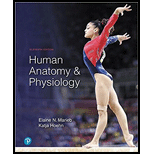
Choose the correct term from the key to respond to the statements describing various brain areas. Key:
a. cerebellum
b. corpora quadrigemina
c. corpus callosum
d. striatum
e. hypothalamus
f. medulla
g. midbrain
h. pons
i. thalamus
______(1) basal nuclei involved in fine control of motor activities
______(2) region where there is a crossover of fibers of descending pyramidal tracts
______(3) control of temperature, autonomic nervous system reflexes, hunger, and water balance
______(4) houses the substantia nigra and cerebral aqueduct
______(5) relay stations for visual and auditory stimuli input; found in midbrain
______(6) houses vital centers for control of the heart, respiration, and blood pressure
______(7) brain area through which all the sensory input is relayed to get to the cerebral cortex
______(8) brain area most concerned with equilibrium, body posture, and coordination of motor activity
Want to see the full answer?
Check out a sample textbook solution
Chapter 12 Solutions
HUMAN ANATOMY+PHYSIOLOGY-PKG.
- Select the best answer or answers from the choices given: A number of brain structures are listed below. If an area is primarily gray matter, write a in the answer blank; if mostly white matter, respond with b.arrow_forwardAll of the following cranial nerves except the _____ carry parasympathetic fibers. a. vagus d. glossopharyngeal b. facial e. hypoglossal c. oculomotorarrow_forwardLetter and words 1) Which of the following are parts of the central nervous system? I. Nerves II. Spinal Cord III. Brain A. III only C. II and III only B. I and III only D. I , II and III 2) Which among the following is NOT a part of the brain? A. Brain Stem C. Cerebrum B. Cerebellum D. Cranium 3) How does the body react to life-threatening situations? A. The parasympathetic nervous system calms down the body. B. Fight or flight response is turned on by sympathetic nervous system. C. Brain shuts down all the body functions to conserve precious energy. D. All the nerves in the body are activated to increase chances of survival. 4) A loud bang is heard across the room. In reaction to this, people turned their heads towards the noise. Which is the stimulus in this case? A. loud bang C. room B. people D. turning of heads 5) What type of nerve connects the eyes directly to the brain? A. cranial nerve C. spinal nerve B. direct nerve D. tactile nerve 6) What organ system…arrow_forward
- Label the Figure 7.5(Cerebrum, Lateral(A); Diencephalon, Sagittal(B) and Figure 8.1(Eye, Sagittal) below by choosing the letter of the part for each item.arrow_forwardA patient with brain damage and demonstrates the following symptoms: difficulty forming new memories remembering events that have happened five minutes ago Which region of the brain is MOST LIKELY to be damaged? A . amygdala B. hippocampus C. hypothalamusarrow_forwardPick all that is a part of this region of the brain. (in red) I. Supraoptic nucleus II. Habenula III. Thalamus. IV. Subthalamic nuclei V. Neuroendocrine centers II, III, IV, V I, II, III, IV I, II, III, IV, V I, III, Varrow_forward
- What type of memory deficit occurred in patient H.M. after the medial temporal lobe was removed from both hemispheres? a. Mild dissociated amnesia b. Severe anterograde amnesia Oc. Severe retrograde amnesia O d. Mild amnesiaarrow_forwardDuring the monitoring of the patient in the light stage of anesthesia, the __________________ reflex remains present. a.Patellar b.Palpebral c.Pinnal d.Pharynxarrow_forwardMatch the brain injury to the appropriate change in function. Use Figure 20.19 to locate the area injured. a. cessation of breathing b. loss of equilibrium c. loss of use of left arm d. loss of vision e. loss of pain localization in the shoulder ________ 16. The effect of a blow to the back of the head that damages this area. ________ 17. The effect of alcohol on this area. ________ 18. The effect of a head injury (i.e., from diving into a pool) that forces the dens into this area. ________ 19. The effect of a stroke that damages this area. ________ 20. The effect of a stroke that damages this area.arrow_forward
- Choose the action of the cranial nerve and write the letter next to the cranial number. ____ I. A. Movement of lateral rectus muscle ____ II. B. Speech and swallowing—tongue muscles ____ III. C. Taste; facial expression; tears; salivation ____ IV. D. Equilibrium and hearing ____ V. E. Smell ____ VI. F. Movement of superior oblique muscle ____ VII. G. Movement of head and shoulders—sternocleidomastoid and trapezius muscles ____ VIII. H. Vision ____ IX. I. Posterior 1/3 of tongue; taste, swallowing and speech; secretion of saliva ____ X. J. Cutaneous sensations from ophthalmic, maxillary, and mandibular areas; chewing ____ XI. K. Taste; pharynx and epiglottis sensations; swallowing, coughing; voice production; smooth muscle of GI tract; secretion of digestive glands; slows heart rate ____ XII. L. Movement of 4 extrinsic eye muscles; accommodation of lens; pupillary constrictionarrow_forwardWhich area of the brain is most directly involved in the reflex control of the autonomic system? a. Hypothalamus b. Cerebral cortex c. Medulla oblongata d. Cerebellumarrow_forwardThe _____________ nerve innervates the anterior thigh muscles and the skin on the anterior thigh. a. femoral c. sciatic b. obturator d. tibialarrow_forward
 Comprehensive Medical Assisting: Administrative a...NursingISBN:9781305964792Author:Wilburta Q. Lindh, Carol D. Tamparo, Barbara M. Dahl, Julie Morris, Cindy CorreaPublisher:Cengage Learning
Comprehensive Medical Assisting: Administrative a...NursingISBN:9781305964792Author:Wilburta Q. Lindh, Carol D. Tamparo, Barbara M. Dahl, Julie Morris, Cindy CorreaPublisher:Cengage Learning
